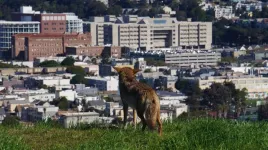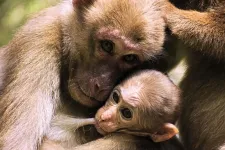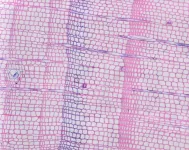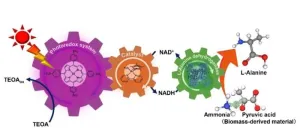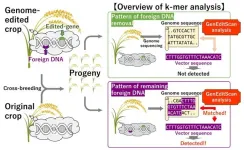(Press-News.org) Is there only one optimal configuration an organism can reach during evolution? Is there a single formula that describes the trajectory towards the optimum? And can we ‘derive’ it in a purely theoretical fashion? A team of researchers, including from the Institute of Science and Technology Austria (ISTA), has answers. Their mathematical model forecasts the ideal body plan of a fruit fly’s early embryo, suggesting that evolution might had many optimal options at its disposal.
It is hypothesized that optimization is the secret sauce for many of nature’s fascinating phenomena, suggesting the world is driven toward a state of minimal energy, the most efficient output, or the highest fitness. Whether it is pods of whales or collectives of tiny cells, life’s building blocks have been selected to self-organize close to peak efficiency.
The development of an animal embryo, from a small cluster of cells to a multicellular organism, might also have been optimized and fine-tuned to an almost perfect system. However, a precise mathematical formula predicting the optimal structure has been elusive until now.
Physicists from the Institute of Science and Technology Austria (ISTA), the Frankfurt Institute for Advanced Studies, and Princeton University now present exactly that: A theoretical model of the fruit fly’s early embryonic development, nearly two decades in the making. With their detailed model, they could theoretically derive and thus predict the optimal ‘wiring’ of the gene-regulation network that controls the early developmental processes. The results are published in PNAS.
Evolution = Optimization
Evolution is the driving force for every organism. Given its environment, an organism adapts, survives, and withstands selective pressure. “Adaptation can be seen as an optimization process, or at least as a process that requires optimization of certain traits and functions,” explains Thomas Sokolowski, first author of the study.
Compared to physical systems, where optimization typically leads to a final state with the lowest energy, biological systems seem to have multiple optimal solutions for the same problem. For instance, eyes evolved independently in various animals, yet their overall structure is remarkably similar across species.
“Eyes were optimized for the same well-defined objective function, which is maximal uptake of light and its encoding into neural spikes. They are therefore strongly dictated by laws of physics. Nuanced differences between animals may be explained by differences in the side circumstances under which they evolved,” Sokolowski continues.
Also for the development of various embryos, many diverse strategies have evolved. They all share the same outcome: a highly precise and reproducible body plan. While these strategies were likely shaped and improved by evolution to serve specific purposes, it is quite difficult to pinpoint which purpose dominated the optimization process.
“It is increasingly clear how an embryo develops, but it is not clear which mathematical function guides the system to come together,” Sokolowski says. “It’s like finding a mathematical needle in the biological haystack.”
The fruit fly
Drosophila, as biologists refer to it, is a widely studied organism, probably best known for the 1995 Noble Prize-winning work of Eric Wieschaus, Christiane Nüsslein-Volhard, and Edward B. Lewis. They identified the genes that are crucial for the correct development of the fly, in particular, the so-called “gap genes” and morphogen (signaling molecule) gradients that control them.
The gap gene network plays a crucial role during the development of the embryo’s head-to-tail axis. This “genetic positioning system” helps individual cells acquire the right fate in the right place, ultimately forming the segmented body of a fruit fly. The varying activation levels of the gap genes form an incredibly precise “positional code” along this axis, providing each cell with exactly the right information on where they are located within the embryo.
Time flies
Already twenty years ago, work by William Bialek, Gašper Tkačik, Curtis Callan, Aleksandra Walczak, Thomas Gregor, and others suggested that the gap gene network in the fruit fly has been fine-tuned by evolution for providing high positional information with a limited number of signaling molecules, much like providing a precise GPS signal with the smallest number of satellites. The scientists therefore came up with the key idea of finding a mathematical function to explain this phenomenon.
In the first attempt, Tkačik and colleagues looked at simplified theoretical models that implemented only parts of the regulatory mechanisms of the gap gene network. They gradually increased the model complexity to make it more realistic. While these “toy” models did not capture all combined characteristics of the gap gene system, they still paved the way toward a full optimization attempt.
“Our early work showed that it was possible to obtain nontrivial and originally unexpected predictions for gene regulatory interactions by optimizing them for maximal information throughput under realistic biophysical and molecular resource constraints,” says Tkačik.
Meanwhile, Thomas Sokolowski and colleagues have been studying detailed stochastic models—models that explicitly include randomness—of spatially interacting genes akin to the gap genes. Sokolowski then joined the Tkačik group at ISTA in 2014, which created a unique opportunity to combine the original optimization approach with detailed spatial-stochastic modeling. Together, the scientists quickly managed to implement a spatial-stochastic model that, on the one hand, was realistic about what happens in the actual fruit fly and, on the other hand, computationally efficient.
Initially being a simplified version with only two genes, the model was extended to the full set of four interacting gap genes and three morphogen gradients, suitable for carrying out fully-featured optimizations of the gap gene system. “Remarkably, the optimal networks we derived closely matched characteristic features of the spatial gene expression profiles observed in the real fruit fly,” Tkačik continues.
Many “optimal” ways
Additionally, the scientists found out that there is more than one optimal way for encoding positional information in the gap network. Different sets of biophysical parameters can lead to the required optimal properties of the system. While being only a tiny subset of all physically possible solutions, the optimal solutions still display a remarkable variety.
“We believe this is not a detriment, but an advantage for evolution, as the same fitness can be potentially reached by many imaginable evolutionary paths,” Sokolowski suggests. “While the evolution that led to Drosophila which we study today followed one particular path, the fact that many alternative routes potentially exist may have facilitated its access to a fit organism.” The more options are available, the higher are the chances to select a functional one.
To understand the processes leading to functional body plans in more detail and get a more accurate representation of the actual evolutionary dynamics, the researchers will require additional modeling that goes beyond numerical optimization of parameters. This will involve taking into account factors such as environmental influences or the mechanisms of natural selection—an intriguing and challenging quest for future research in theoretical biology.
END
Many Roads Lead to… the embryo
ISTA shows evolution had many optimal outcomes to choose from
2025-01-22
ELSE PRESS RELEASES FROM THIS DATE:
Dining out with San Francisco’s coyotes
2025-01-22
As their traditional dining options dwindle and natural areas give way to restaurants, homes and sidewalks, the coyotes of San Francisco are shifting what they eat.
Scientists from the University of California, Davis, wanted to understand what San Francisco’s coyotes are eating, and how their diet is changed and shaped by the city’s landscape, which can vary from block to block.
Their study, published in the journal Ecosphere, found that the number of restaurants and amount of pavement or “impervious surfaces” within the city heavily influenced what the coyotes ...
What’s the mechanism behind behavioral side effects of popular weight loss drugs?
2025-01-22
Glucagon-like peptide 1 receptor agonists (GLP1RA)—medications for type 2 diabetes and obesity that have recently been making headlines due to a rise in popularity as weight loss agents—have been linked with behavioral side effects. A large population-based analysis in Diabetes, Obesity and Metabolism assessed whether certain genetic variants might help explain these effects.
GLP1RA mimic the GLP-1 hormone in the body that helps control insulin and blood glucose levels and promotes feelings of satiety. GLP-1 ...
How employee trust in AI drives performance and adoption
2025-01-22
Many companies are making substantial investments in artificial intelligence (AI), which can enhance decision-making processes, foster innovation, increase productivity, and have other advantages. New research published in the Journal of Management Studies shows that company employees’ perceptions of how well AI performs (cognitive trust) and feelings towards AI (emotional trust) vary, and that these perceptions can affect AI performance and adoption in organizations.
Interviews with employees of a medium-sized software development firm revealed four different ...
Does sleep apnea treatment influence patients’ risk of getting into car accidents?
2025-01-22
Sleepiness at the wheel is a significant contributing factor to motor vehicle accidents. A new analysis published in Otolaryngology–Head and Neck Surgery reveals that for people with sleep apnea, getting surgery for their condition may lessen their risk of such accidents compared with using a Continuous Positive Airway Pressure (CPAP) device at night or receiving no treatment.
In the analysis of data on 2,832,437 patients with obstructive sleep apnea, 3.4% of patients who underwent surgery were in a car accident at any point following their diagnosis, compared with 6.1% of those using a CPAP and 4.7% of those not receiving any treatment.
Patients ...
Do minimum wage hikes negatively impact students’ summer employment?
2025-01-22
New research in Contemporary Economic Policy indicates that rising minimum wages in a state are associated with reduced summer employment for college students, the time when students tend to work the most.
The study, which involved data from a public university and quarterly work records from Washington State, found that college students’ employment and hours worked decrease as minimum wages rise in the summer quarter. Students experiencing the largest reductions are those with little or no work experience ...
Exposure to stress during early pregnancy affects offspring into adulthood
2025-01-22
Maternal stress hormone levels during early pregnancy can have a lasting effect on the stress system of the offspring. The results of a long-term study on wild Assamese macaques in Thailand indicate that maternal stress in the first half of pregnancy is particularly relevant. Elevated stress hormones later during pregnancy or after birth did not have the same effects. The long-term study conducted by the University of Göttingen and the German Primate Center – Leibniz Institute for Primate Research provides important insights into the ...
Curious blue rings in trees and shrubs reveal cold summers of the past — potentially caused by volcanic eruptions
2025-01-22
When the going gets cold, even tough trees struggle with growing. Trees need a certain number of warm days in their growing seasons to grow properly; otherwise, the cell walls of new growth don’t lignify properly, creating ‘blue rings’ that appear when wood samples are dyed. Since trees and shrubs can live for hundreds of years, identifying these blue rings allows us to spot cold summers in the past. By looking at pine trees and juniper shrubs from northern Norway, scientists identified two extremely cold summers in 1902 and 1877, possibly caused by the eruptions of Mount Pelée on the island of Martinique and ...
New frontiers in organic chemistry: Synthesis of a promising mushroom-derived compound
2025-01-22
Natural compounds from plants and animals have long been used in drug development, but mushrooms remain underexplored despite their rich chemical potential. Now, researchers from Japan have successfully developed the first method to synthesize inaoside A, a compound derived from the edible mushroom Laetiporus cremeiporus. This achievement will help better understand more of its bioactive properties and pave the way for similar mushroom-derived compounds in pharmaceuticals and functional foods.
Natural compounds derived from plants and animals have long been a source of inspiration when developing drugs and dietary supplements. Many well-established medical ...
Biodegradable nylon precursor produced through artificial photosynthesis
2025-01-22
Nylon, the durable and elastic material, is like other plastics made from chemicals found in fossil fuels. Biodegradable plastics based on biomass-derived compounds are attracting attention as an alternative to conventional plastics, and Osaka Metropolitan University scientists have now synthesized biodegradable nylon precursors.
Professor Yutaka Amao’s team at the Research Center for Artificial Photosynthesis previously reported on a method for producing raw materials for biodegradable plastics from biomass-derived compounds. ...
GenEditScan: novel k-mer analysis tool based on next-generation sequencing for foreign DNA detection in genome-edited products
2025-01-22
Genetic changes have the ability to alter crop characteristics, and some crop breeding techniques take advantage of this. Conventionally, genetic engineering has relied on natural or artificial mutations. In recent years, genome editing technology has been grabbing attention. Genome editing technology can target and cut specific DNA sequences, causing mutations in target genes. This makes it possible to develop new cultivars efficiently.
A common method for creating genome-edited crops involves introducing foreign DNA temporarily that produces an enzyme to cut the target ...
LAST 30 PRESS RELEASES:
Making lighter work of calculating fluid and heat flow
Normalizing blood sugar can halve heart attack risk
Lowering blood sugar cuts heart attack risk in people with prediabetes
Study links genetic variants to risk of blinding eye disease in premature infants
Non-opioid ‘pain sponge’ therapy halts cartilage degeneration and relieves chronic pain
AI can pick up cultural values by mimicking how kids learn
China’s ecological redlines offer fast track to 30 x 30 global conservation goal
Invisible indoor threats: emerging household contaminants and their growing risks to human health
Adding antibody treatment to chemo boosts outcomes for children with rare cancer
Germline pathogenic variants among women without a history of breast cancer
Tanning beds triple melanoma risk, potentially causing broad DNA damage
Unique bond identified as key to viral infection speed
Indoor tanning makes youthful skin much older on a genetic level
Mouse model sheds new light on the causes and potential solutions to human GI problems linked to muscular dystrophy
The Journal of Nuclear Medicine ahead-of-print tip sheet: December 12, 2025
Smarter tools for peering into the microscopic world
Applications open for funding to conduct research in the Kinsey Institute archives
Global measure underestimates the severity of food insecurity
Child survivors of critical illness are missing out on timely follow up care
Risk-based vs annual breast cancer screening / the WISDOM randomized clinical trial
University of Toronto launches Electric Vehicle Innovation Ontario to accelerate advanced EV technologies and build Canada’s innovation advantage
Early relapse predicts poor outcomes in aggressive blood cancer
American College of Lifestyle Medicine applauds two CMS models aligned with lifestyle medicine practice and reimbursement
Clinical trial finds cannabis use not a barrier to quitting nicotine vaping
Supplemental nutrition assistance program policies and food insecurity
Switching immune cells to “night mode” could limit damage after a heart attack, study suggests
URI-based Global RIghts Project report spotlights continued troubling trends in worldwide inhumane treatment
Neutrophils are less aggressive at night, explaining why nighttime heart attacks cause less damage than daytime events
Menopausal hormone therapy may not pose breast cancer risk for women with BRCA mutations
Mobile health tool may improve quality of life for adolescent and young adult breast cancer survivors
[Press-News.org] Many Roads Lead to… the embryoISTA shows evolution had many optimal outcomes to choose from


